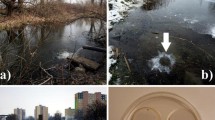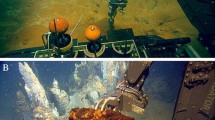Abstract
‘Produced water’ is a term used in oil industry to describe water produced along with oil and gas from oil reservoir. Microorganisms have been frequently isolated from produced water/oil reservoirs; however, there is paucity of information regarding the diversity and characterization of bacterial flora from Indian oil reservoirs. The present investigation was undertaken to study bacterial diversity associated with Indian oil reservoirs and to investigate their potential as a source of industrially valuable enzymes. A total of 103 strains were isolated from five oil reservoirs. PCR-based DNA fingerprinting grouped these strains into 72 genovars. These isolates were identified using morphological, phenotypical and phylogenetic analyses. Most of these isolates were thermophiles (growing at 45°C or higher), halotolerant (growth at 5% salinity) and were distributed through a variety of genera including but not limited to Bacillus, Chelatococcus, Paenibacillus and Pseudomonas species. The 16S rRNA gene sequence of several strains shared less than 97% homology with the reference sequences in the GenBank database indicating taxonomic novelty of these strains. Assessment of the biotechnological potential of 72 genovars revealed that majority of strains produce one or many of the valuable enzymes including amylase, cellulase, xylanase, pectinase, inulinase, protease, alcohol dehydrogenase and urease. Most of the isolates also degraded crude oil or petroleum hydrocarbons. The vast pool of phenotypic, genetic and functional diversity of the strains retrieved in this study suggested oil reservoirs as yet largely untapped and potent source of taxonomically novel and biotechnologically valuable microorganisms.
Similar content being viewed by others
Abbreviations
- DGGE:
-
denaturing gradient gel electrophoresis
References
Bastin E.S., Greer F.E., Merritt C.A. & Moulton G. 1926. The presence of sulphate reducing bacteria in oil field waters. Science 63: 21–24.
Beeder J., Torsvik T. & Lien T. 1995. Thermodesulforhabdus norvegicus gen. nov., sp. nov., a novel thermophilic sulfatereducing bacterium from oil field water. Arch. Microbiol. 164: 331–336.
Cheng L., Qiu T., Li X., Wang W. & Deng Y. 2008. Isolation and characterization of Methanoculleus receptaculi sp. nov. from Shengli oil field, China. FEMS Microbiol. Lett. 285: 65–71.
Chi Z., Chi Z., Zhang T., Liu G. & Yue L. 2009. Inulinaseexpressing microorganisms and applications of inulinase. Appl. Microbiol. Biotechnol. 82: 211–220.
Conway T., Sewell G.W., Osman Y.A. & Ingram L.O. 1987. Cloning and sequencing of the alcohol dehydrogenase II gene from Zymomonas mobilis. J. Bacteriol. 169: 2591–2597.
Dopazo J. 1994. Estimating errors and confidence intervals for branch lengths in phylogenetic trees by a bootstrap approach. J. Mol. Evol. 38: 300–304.
Eckford R.E. & Fedorak P.M. 2002. Planktonic nitrate-reducing bacteria and sulphate-reducing bacteria in some western Canadian oil field waters. J. Ind. Microbiol. Biotechnol. 29: 83–92.
Famuyiwa O.O. & Ouch C.S. 1991. Modification of acid urease activity by fluoride ions and malic acid in wines. Am. J. Enol. Vitic. 42: 79–80.
Friedrich A. & Antranikian G. 1996. Keratin degradation by Fervidobacterium pennavorans, a novel thermophilic anaerobic species of the order Thermotogales. Appl. Environ. Microbiol. 62: 2875–2882.
Fujinawa S.B. G. & Dela T.P. 1990. Application of acid urease to reduction of urea in commercial wines. Am. J. Enol. Vitic. 42: 350–354.
Grassia G.C., McLean K.M., Glénat P., Bauld J. & Sheehy A. 1996. A systematic survey for thermophilic fermentative bacteria and archaea in high temperature petroleum reservoirs. FEMS Microbiol. Ecol. 21: 47–58.
Gupta R., Beg Q.K. & Lorentz P. 2002. Bacterial alkaline proteases: molecular approaches and industrial application. Appl. Microbiol. Biotechnol. 59: 15–32.
Hayes T. & Arthur D. 2004. Overview of emerging produced water treatment technologies. The 11th Annual International Petroleum Environmental Conference, Albuquerque, NM, October 12–15, 2004; http://ipec.utulsa.edu/Conf2004/Papers/hayes arthur.pdfConf2004/Papers/hayes arthur.pdf.
Holt J.G., Krieg N.R., Sneath P.H.A., Stanley J.T. & Williams S.T. 1994. Bergey’s Manual of Determinative Bacteriology, 9th Edition. The Williams and Wilkins Company, Baltimore.
Hui L., Ai M., Han S., Guo Y., Li N., Shi R. Zeng X. Leng S., Zhao J., Liu X. & Zhang Y. 2012. Microbial diversity and functionally distinct groups in produced water from the Daqing Oilfield, China. Petroleum Sci. 9: 469–484.
Jorgensen S., Vorgias C.E. & Antranikian G. 1997. Cloning, sequencing and expression of an extracellular α-amylase from the hyperthermophilic archeon Pyrococcus furiosus in Escherichia coli and Bacillus subtilis. J. Biol. Chem. 272: 16335–16342.
Kapoor M., Beg Q.K., Bhushan B., Singh K., Dadhich K.S. & Hoondal G.S. 2001. Application of an alkaline and thermostable polygalacturonase from Bacillus sp. MG-cp-2 in degumming of ramie (Boehmerianivea) and sunn hemp (Crotalaria juncea) bast fibers. Process Biochem. 36: 803–807.
Kashyap D.R., Vohra P.K., Chopra S. & Tewari R. 2001. Applications of pectinases in the commercial sector: a review. Bioresour. Technol. 77: 215–227.
Kuhad R.C. & Singh A. 1993. Lignocellulose biotechnology: current and future prospects. Crit. Rev. Biotechnol. 13: 151–172.
Leuschner C. & Antranikian G. 1995 Heat-stable enzymes from extremely thermophilic and hyperthermophilic microorganisms. World J. Microbiol. Biotechnol. 11: 95–114.
Li X., Cheng L., Wang W., Deng Y. & Yin X. 2008. Isolation and characterization of Thermoanaerobacter mathranii SC-2 from oil-field water. Acta Microbiol. Sinica 48: 1574–6968.
Machielsen R., Uria A.R., Kengen S.W.M. & Oost J.V.D. 2006. Production and characterization of a thermostable alcohol dehydrogenase that belongs to the aldo-keto reductase superfamily. Appl. Environ. Microbiol. 72: 233–238.
Magot M. 2005. Indigenous microbial communities in oil fields, pp.?21–33. In: Ollivier B. & Magot M. (eds) Petroleum Microbiology, ASM Press, Washington.
Magot M., Ollivier B. & Patel B.K.C. 2000. Microbiology of petroleum reservoirs. Antonie Van Leeuwenhoek 77: 103–116.
Malatova K. 2005. Isolation and characterization of hydrocarbon degrading bacteria from environmental habitats in western New York State. M.S. Thesis, Rochester Institute of Technology, Rochester, NY, 108 pp.
Muyzer G., de Waal E.C. & Uitterlinden A.G. 1993. Profiling of complex microbial populations by denaturing gradient gel electrophoresis analysis of polymerase chain reactionamplified genes coding for 16S rRNA. Appl. Environ. Microbiol. 59: 695–700.
Nazina T.N., Tourova T.P., Poltaraus A. B., Novikova E.V., Grigoriyan A.A., Ivanova A.E., Petrunyaka V.V., Osipov G.A., Belyaev S.S. & Ivanov M.V. 2001. Taxonomic study of aerobic thermophilic bacilli: descriptions of Geobacillus subterraneus, gen. nov., sp. nov. and Geobacillus uzenensis, sp. nov. from petroleum reservoirs and transfer of Bacillus stearothermophilus, Bacillus thermocatenulatus, Bacillus thermooleovorans, Bacillus kaustophilus, Bacillus thermoglucosidasius, Bacillus thermoglucosidasius and Bacillus thermodenitrificans to Geobacillus, as the new combinations G. stearothermophilus, G. thermocatenulatus, G. thermoleovorans, G. kaustophilus, G. thermoglucosidasius, and G. thermodenitrificans. Int. J. Syst. Evol. Microbiol. 51: 433–446.
Nilsen R.K. & Torsvik T. 1996. Methanococcus thermolithotrophicus isolated from North Sea oil field reservoir water. Appl. Environ. Microbiol. 62: 728–731.
Nilsen R.K., Torsvik T. & Lien T. 1996. Desulfotomaculum thermocisternum sp. nov., a sulfate reducer isolated from a hot North Sea oil reservoir. Int. J. Syst. Bacteriol. 46: 397–402.
Orphan V.J., Taylor L.T., Hafenbradl D. & Delong E.F. 2000. Culture-dependent and culture-independent characterization of microbial assemblage associated with high temperature petroleum reservoirs. Appl. Environ. Microbiol. 66: 700–711.
Rees G.N., Grassia G.S., Sheehy A.J., Dwivedi P.P. & Patel B.K.C. 1995. Desulfacinum infernumgen. nov., sp. nov., a thermophilic sulfate-reducing bacterium from a petroleum reservoir. Int. J. Syst. Bacteriol. 45: 85–89.
Rodriguez-Valera F., Ruiz-Berraquero F. & Ramos-Cormenzana A. 1980. Isolation of extremely halophilic bacteria able to grow in defined inorganic media with single carbon sources. J. Gen. Microbiol. 119: 535–538.
Rudiger A., Jorgensen P.L. & Antranikian G. 1995. Isolation and characterization of a heat stable pullulanase from the hyperthermophilic archeon Pyrococcus woesei after cloning and expression of its gene in Escherichia coli. Appl. Environ. Microbiol. 61: 567–575.
Saitou N. & Nei M. 1987. The neighbor-joining method: a new method for reconstructing phylogenetic trees. Mol. Biol. Evol. 4: 406–425.
Sathe S. J., Nawani N.N., Dhakephalkar P.K. & Kapadnis B.P. 2007. Antifungal lactic acid bacteria with potential to prolong shelf-life of fresh vegetables. J. Appl. Microbiol. 103: 2622–2628.
Sjodahl J., Emmer A., Vincent J. & Roeraade J. 2002 Characterization of proteinases from Antarctic krill (Euphausiasuperba). Protein Expres. Purif. 26: 153–161.
Slobodkin A.I., Jeanthon C., L’ Haridon S., Nazina T.N., Miroshnichenko M.L. & Bonch-Osmolovskaya E.A. 1999. Dissimilatory reduction of Fe(III) by thermophilic bacteria and archaea in deep subsurface petroleum reservoirs of Western Siberia. Curr. Microbiol. 39: 99–102.
Smith P.T., Douglas A.K. J. & Goodman N. 1993. Isolation and characterization of urease from Aspergillus niger. J. Gen. Microbiol. 139: 957–962.
Suzuki M.T., Rappé M.S., Haimberger Z.W., Winfield H., Adair N., Ströobel J. & Giovannoni S.J. 1997. Bacterial diversity among small-subunit rRNA gene clones and cellular isolates from the same seawater sample. Appl. Environ. Microbiol. 63: 983–989.
Tamura K., Peterson D., Peterson N., Stecher G., Nei M. & Kumar S. 2011. MEGA5: Molecular evolutionary genetics analysis using maximum likelihood, evolutionary distance, and maximum parsimony methods. Mol. Biol. Evol. 28: 2731–2739.
Virupakshi S., Babu K.G., Gaikwad S.R. & Naik G.R. 2005. Production of a xylanolytic enzyme by a thermoalkaliphilic Bacillus sp. JB-99 in solid state fermentation. Process Biochem. 40: 431–435.
Watanabe K., Kodama Y. & Harayama S. 2001. Design and evaluation of PCR primers to amplify 16S ribosomal DNA fragments used for community fingerprinting. J. Microbiol. Methods 44: 253–262.
Acknowledgements
Ms. Preeti Arora acknowledges the support from CSIR for their financial assistance. Support from IRS-ONGC is also gratefully acknowledged.
Author information
Authors and Affiliations
Corresponding author
Additional information
Based on a contribution presented at the International Conference on Advances in Biotechnology & Bioinformatics (ICABB-2013), November 25–27, 2013, Pune, Maharashtra, India
Rights and permissions
About this article
Cite this article
Saxena, N., Pore, S., Arora, P. et al. Cultivable bacterial flora of Indian oil reservoir: isolation, identification and characterization of the biotechnological potential. Biologia 70, 1–10 (2015). https://doi.org/10.1515/biolog-2015-0017
Received:
Accepted:
Published:
Issue Date:
DOI: https://doi.org/10.1515/biolog-2015-0017




